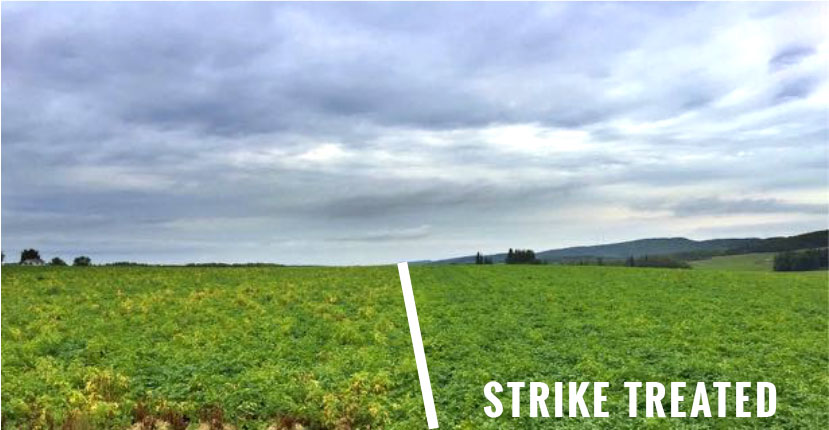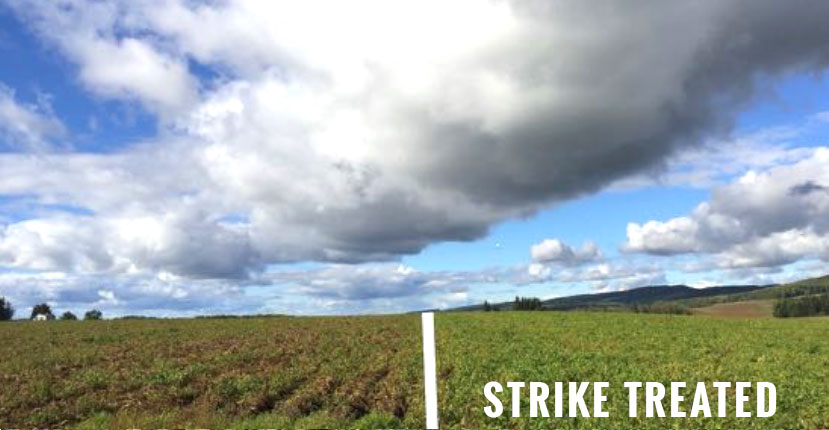Years of safe use.
2020…2003…1995…1980…1975…1969
Chloropicrin, Strike’s main ingredient, has been used in agriculture for over 50 years. It has recently been identified as valuable for commodity crops. Over time with Strike, you can reduce disease in a field. Reduced disease means reduced usage of Strike until disease returns. Strike helps to change the balance suppressing disease and promoting soil beneficials.
The suppression of soil borne disease and the repopulation of native, plant-beneficial organisms are what make Strike like no other fumigant.
Case Study: See why Jay Savage of Savage Farms wished he had known about Strike sooner.
Watch this: Strike + Savage Farms
Field Trials
We have partnered with growers on over 30 replicated potato trials in 13 states/provinces. Our goal is to build relationships and understanding of a new product and new approach to tuber farming. We are not just selling a product, but rather a crop “production” enhancement. From start to finish our product can change the production at your farm.
CASE STUDY 1: 2019 Central Wisconsin Russet Burbank Soil Fumigation Trial.
The treatments were Non-Treated, Vapam (40 gpa, broadcast fall applied, grower standard treatment), and Strike 85 (117 lb/A, fall applied, in-row). Plants in the chloropicrin soil treatment produced 25,000 tubers/A more than plants in the Vapam treatment. This tuber set increased improved marketable yield by 61 cwt/A in the Strike 85 treatments compared to the Vapam treatment. This field was vine-killed in mid-September when plants in the non-treated and Vapam treatments were already declining from early die systems. Conversely, potato plants in the Strike 85 treatment were green and productive at the time of vine-killing. At vine-kill, plants in the Strike 85 treatment had 19,800 more tubers in ‘1 ⅞” to 6 oz.’ size class than plants in the Vapam treatment. A week more growth from vine killing would have increased the marketable yield benefit observed in the Strike 85 treatment. Some of the nearly 20,000 tubers/A would have grown to the ‘6 to 10 oz.’ size class improving marketable yield even further. When potato early die is managed with chloropicrin, managing tuber bulking through season length is important to maximize return on investment when using chloropicrin soil treatment.
| Treatment | Stems/Plant | Specific Gravity | Culls | <1 7⁄8″ | 1 7⁄8″ – 6oz | 6 – 10oz | Bonus >10oz | GRD 1 1 7⁄8″ – 10oz |
Mkt Yield | Total Yield |
|---|---|---|---|---|---|---|---|---|---|---|
| Non-Treated | 2.8 | — | 3 | 115 | 159 | 107 | 22 | 266 | 288 | 406 |
| Vapam, 40 gpa | 3.2 | — | 4 | 100 | 201 | 147 | 56 | 348 | 404 | 508 |
| Strike 85, 117 lb/A in-row | 3.6 | — | 2 | 86 | 238 | 173 | 55 | 411 | 465 | 554 |
| Difference | 0.35 | — | -1.5 | -14.4 | 36.9 | 25.4 | -1 | 62 | 61 | 45 |
| T-Test (p value) | 0.555 | — | 0.445 | 0.264 | 0.034 | 0.246 | 0.951 | 0.007 | 0.030 | 0.045 |
Table 2. Russet Burbank Yield Data (tubers/planted A) for a 2019 Soil Fumigation Trial in Central Wisconsin
| Treatment | Stems/Plant | Culls | <1 7⁄8″ | 1 7⁄8″ – 6oz | 6 – 10oz | Bonus >10oz | GRD 1 1 7⁄8″ – 10oz |
Mkt Yield | Total Yield |
|---|---|---|---|---|---|---|---|---|---|
| – 1,000 tubers/A – | |||||||||
| Non-Treated | 2.8 | 1.1 | 115 | 60 | 23 | 3 | 83 | 87 | 203 |
| Vapam, 40 gpa | 3.2 | 1.1 | 105 | 75 | 32 | 8 | 107 | 115 | 221 |
| Strike 85, 117 lb/A in-row | 3.6 | 0.7 | 101 | 95 | 38 | 7 | 133 | 140 | 241 |
| Difference | 0.35 | — | -4.4 | -19.8 | 5.4 | -0.4 | 25 | 25 | 20 |
| T-Test (p value) | 0.555 | — | 0.708 | 0.011 | 0.022 | 0.876 | 0.001 | 0.001 | 0.109 |
CASE STUDY 2: 2018 Aroostook County, Maine Shepody Soil Fumigation Trial.
Shepody is a short-season russet-skinned variety used for early season processing. Shepody has many of the needed processing characteristics, however, it is notoriously known for a relatively low poor set and low yield. In 2018 in Aroostook County, Maine, Shepody was planted in a grower standard production system (non-fumigated) and ground that had fall applied Strike 85 (115 lb Strike 85/A). Potato plants grown in the Strike 85 treatment produced 80 and 75 cwt/A more total and marketable yield compared to potato plants in the grower standard treatment. Plants in the Strike 85 treatment produced 40 cwt/A more yield in the greater than 10 oz. size class. These yield increases were driven by a set increase in plants in the Strike 85 treatments. These plants produced 16,700 more tubers in a marketable class compared to plants in the non-fumigated areas. Plants grown in Strike 85 produced more tubers plant which translated into an increase of 75 cwt/A turning a relatively poor yielding, early-season, processing variety into a better economic proposition.
September 8, 2016

September 23, 2016

| Treatment | Stems/Plant | Specific Gravity | Culls | <1 7⁄8″ | 1 7⁄8″ – 6oz | 6 – 10oz | Bonus >10oz | GRD 1 1 7⁄8″ – 10oz |
Mkt Yield | Total Yield |
|---|---|---|---|---|---|---|---|---|---|---|
| Bedded – Non-Fumigated | 3.1 | 1.086 | 0.0 | 16 | 83 | 120 | 56 | 203 | 259 | 274 |
| Bedded – 115 lb ai Strike 85/A | 3.0 | 1.080 | 0.0 | 20 | 109 | 129 | 95 | 238 | 334 | 354 |
| Difference | 0.0 | 0 | 0.0 | 4 | 26 | 9 | 40 | 35 | 75 | 80 |
| T-Test (p value) | 0.077 | — | 0.225 | 0.059 | 0.570 | 0.028 | 0.069 | 0.000 | 0.000 |
Table 2. Shepody Yield Data (tubers/planted A) for the 2018 Soil Fumigation Trial in Aroostook County, Maine
| Treatment | Stems/Plant | Culls | <1 7⁄8″ | 1 7⁄8″ – 6oz | 6 – 10oz | Bonus >10oz | GRD 1 1 7⁄8″ – 10oz |
Mkt Yield | Total Yield |
|---|---|---|---|---|---|---|---|---|---|
| – 1,000 tubers/A – | |||||||||
| Bedded – Non-Fumigated | 3.1 | 0 | 17 | 30 | 25 | 7 | 55 | 62 | 79 |
| Bedded – 115 lb ai Strike 85/A | 3.0 | 0 | 22 | 39 | 27 | 12 | 67 | 79 | 101 |
| Difference | 0.0 | 0.0 | 5 | 9 | 2 | 5 | 12 | 16.7 | 21.6 |
| T-Test (p value) | 0.077 | 0.277 | 0.049 | 0.504 | 0.028 | 0.026 | 0.001 | 0.016 | |
Increase (tubers/plt;tubers/A) of Plants Grown in Chloropicrin Fumigated Soil Over Plants in Non-Treated Soil in Maine.
| Trial By Year | Marketable Yield/A(cwt) | Total Yield/A (cwt) | Marketable Tubers/Plt | Marketable Tubers/A | Total Tubers/Plt | Total Tubers/A |
|---|---|---|---|---|---|---|
| 2016 (3 trials) |
107 | 116 | 1.57 | 15,633 | 2.31 | 25,467 |
| 2017 (12 trials) |
98 | 99 | 1.79 | 19,242 | 3.10 | 32,875 |
| 2018 (9 trials) |
77 | 81 | 2.17 | 23,111 | 2.95 | 31,789 |
| Grand Mean (24) |
94 | 99 | 1.84 | 19,329 | 2.79 | 30,044 |
| 26.3% | 74,208/ha |
-
Strike improved tuber set.
-
Strike improved yield.
-
Yield dependent on weather & management.